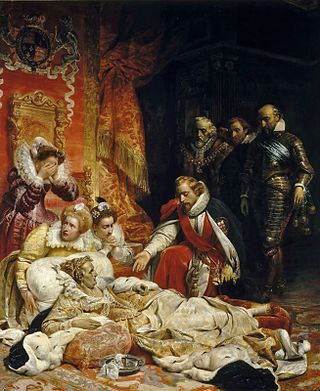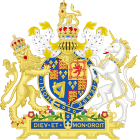
The Act of Settlement is an Act of the Parliament of England that settled the succession to the English and Irish crowns to only Protestants, which passed in 1701. More specifically, anyone who became a Roman Catholic, or who married one, became disqualified to inherit the throne. This had the effect of deposing the remaining descendants of Charles I, other than his Protestant granddaughter Anne, as the next Protestant in line to the throne was Sophia of Hanover. Born into the House of Wittelsbach, she was a granddaughter of James VI and I from his most junior surviving line, with the crowns descending only to her non-Catholic heirs. Sophia died shortly before the death of Queen Anne, and Sophia's son succeeded to the throne as King George I, starting the Hanoverian dynasty in Britain.

The monarchy of the United Kingdom, commonly referred to as the British monarchy, is the constitutional form of government by which a hereditary sovereign reigns as the head of state of the United Kingdom, the Crown Dependencies and the British Overseas Territories. The current monarch is King Charles III, who ascended the throne on 8 September 2022, upon the death of his mother, Queen Elizabeth II.

James VI and I was King of Scotland as James VI from 24 July 1567 and King of England and Ireland as James I from the union of the Scottish and English crowns on 24 March 1603 until his death in 1625. Although he long tried to get both countries to adopt a closer political union, the kingdoms of Scotland and England remained individual sovereign states, with their own parliaments, judiciaries, and laws, both ruled by James in personal union.

The Kingdom of England was a sovereign state on the island of Great Britain from 12 July 927, when it emerged from various Anglo-Saxon kingdoms, until 1 May 1707, when it united with Scotland to form the Kingdom of Great Britain, and England is now part of the United Kingdom. The Kingdom of England was among the most powerful states in Europe during the medieval and early modern colonial periods.

The Union of the Crowns was the accession of James VI of Scotland to the throne of the Kingdom of England as James I and the practical unification of some functions of the two separate realms under a single individual on 24 March 1603. Whilst a misnomer, therefore, what is popularly known as "The Union of the Crowns" followed the death of James's cousin, Elizabeth I of England, the last monarch of the Tudor dynasty.

Succession to the British throne is determined by descent, sex, legitimacy, and religion. Under common law, the Crown is inherited by a sovereign's children or by a childless sovereign's nearest collateral line. The Bill of Rights 1689 and the Act of Settlement 1701 restrict succession to the throne to the legitimate Protestant descendants of Sophia of Hanover who are in "communion with the Church of England". Spouses of Catholics were disqualified from 1689 until the law was amended in 2015. Protestant descendants of those excluded for being Roman Catholics are eligible.

The Act of Supremacy 1558, sometimes referred to as the Act of Supremacy 1559, is an Act of the Parliament of England, which replaced the original Act of Supremacy 1534, and passed under the auspices of Elizabeth I. The 1534 Act was issued by Elizabeth's father, Henry VIII, which arrogated ecclesiastical authority to the monarchy, but which had been repealed by Mary I. Along with the Act of Uniformity 1558, the Act made up what is generally referred to as the Elizabethan Religious Settlement.

The Treasons Act 1571 was an Act of the Parliament of England during the reign of Queen Elizabeth I. It restored the provisions of the Treasons Act 1534, which had been passed by Parliament during the reign of her father, King Henry VIII, and then repealed by the Treason Act 1547 at the beginning of the reign of her half-brother, King Edward VI.

Demise of the Crown is the legal term in the United Kingdom and the Commonwealth realms for the transfer of the Crown upon the death or abdication of the monarch. The Crown transfers automatically to the monarch's heir. The concept evolved in the kingdom of England, and was continued in Great Britain and then the United Kingdom. The concept also became part of the constitutions of the British colonies, and was continued in the constitutions of the Commonwealth realms, until modified within those realms.

The Crown and Parliament Recognition Act 1689 was an Act of the Parliament of England, passed in April 1690 but backdated to the start of the parliamentary session, which started on 20 March 1690.. It was designed to confirm the succession to the throne of King William III and Queen Mary II of England and to confirm the validity of the laws passed by the Convention Parliament which had been irregularly convened following the Glorious Revolution and the end of James II's reign.

The First Statute of Repeal was an Act of the Parliament of England, passed in 1553 in the first Parliament of Mary I's reign, nullified all religious legislation passed under the previous monarch, the boy-king Edward VI, and the de facto rulers of that time, Edward Seymour, 1st Duke of Somerset, and John Dudley, 1st Duke of Northumberland.
The Succession to the Crown Act, or Act of Succession, may refer to a number of pieces of English law passed in the reign of Henry VIII:

The Union of England and Scotland Act 1603, full title An Act authorizing certain Commissioners of the realm of England to treat with Commissioners of Scotland, for the weal of both kingdoms, was an Act of Parliament of the Parliament of England enacted during the reign of King James I. It appointed a commission led by the Lord Chancellor, Lord Ellesmere, to meet and negotiate with a commission which would be appointed by the Parliament of Scotland. The aim of the discussions was to look into the possibility of arranging a formal political union between England and Scotland, going beyond the existing Union of Crowns, and to report back to Parliament. The commission was not effective, however, and similar subsequent proposals also fell flat. The two kingdoms were eventually united over a century later, by the Acts of Union 1707.

The Rebellion Act 1572, full title An Act for the punishment of such as shall rebelliously take or detain or conspire to take or detain from the Queen's Majesty any of her castles, towers, fortresses, holds, &c., was an Act of Parliament of the Parliament of England enacted during the reign of Elizabeth I. It provided that if any person was convicted of conspiring to seize or destroy any castle or fortification held or garrisoned by the Queen's forces, then they and any associates were to be judged felons and suffer the death penalty without benefit of clergy or sanctuary. If any person was to prevent the use of any royal castle or ordnance by the crown, destroy any of the Queen's ships, or prevent the use of a harbour within the realm, then they were to be considered guilty of high treason and sentenced accordingly. The Act remained in force until the death of Elizabeth in 1603, when it expired, and was formally repealed by the Statute Law Revision Act 1863.
The English Protestant Reformation was imposed by the English Crown, and submission to its essential points was exacted by the State with post-Reformation oaths. With some solemnity, by oath, test, or formal declaration, English churchmen and others were required to assent to the religious changes, starting in the sixteenth century and continuing for more than 250 years.
The Reformation in Ireland was a movement for the reform of religious life and institutions that was introduced into Ireland by the English administration at the behest of King Henry VIII of England. His desire for an annulment of his marriage was known as the King's Great Matter. Ultimately Pope Clement VII refused the petition; consequently, in order to give legal effect to his wishes, it became necessary for the King to assert his lordship over the Catholic Church in his realm. In passing the Acts of Supremacy in 1534, the English Parliament confirmed the King's supremacy over the Church in the Kingdom of England. This challenge to Papal supremacy resulted in a breach with the Catholic Church. By 1541, the Irish Parliament had agreed to the change in status of the country from that of a Lordship to that of Kingdom of Ireland.

The succession to the childless Elizabeth I was an open question from her accession in 1558 to her death in 1603, when the crown passed to James VI of Scotland. While the accession of James went smoothly, the succession had been the subject of much debate for decades. It also, in some scholarly views, was a major political factor of the entire reign, if not so voiced. Separate aspects have acquired their own nomenclature: the "Norfolk conspiracy", Patrick Collinson's "Elizabethan exclusion crisis", and the "Secret Correspondence".












